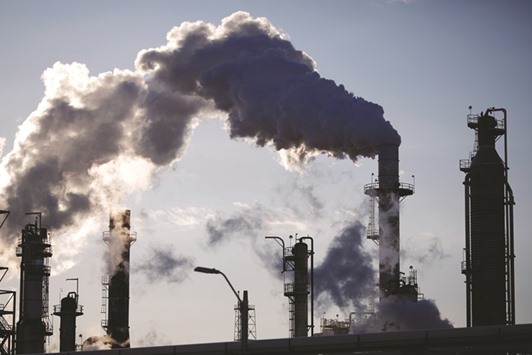Oil prices jumped yesterday after the United States imposed sanctions on some Iranian individuals and entities, days after the White House put Tehran “on notice” over a ballistic missile test.
Front month US West Texas Intermediate crude futures climbed 24¢ to $53.78, after closing 34¢ down on Thursday, as of 12:22pm ET (1722 GMT). The contract is up nearly 1% on the week.
Brent crude futures were up 30¢ at $56.86 a barrel; it was on track for a more than 2% gain since Monday, its first significant weekly rise this year.
Volume in US crude futures was relatively low yesterday, with about 335,000 contracts changing hands by 12:15pm, on track to fall short of the 200-day moving average for 528,000 contracts.
Analysts said the market is torn between promised cuts from the Organisation of the Petroleum Exporting Countries (Opec) and fears over rising US shale oil production.
“While the market is taking these actions in stride so far as unlikely to result in a larger military conflict that would put Gulf crude oil supplies at risk, the odds of that scenario are certainly higher than a week ago,” wrote Timothy Evans, energy analyst at Citi Futures in New York.
Trump had warned on Twitter that “Iran is playing with fire” after its missile test.
“The ‘trumperament’ of the new US president is being tested by Iran and soon maybe also by Russia and China,” said Olivier Jakob, managing director of consultancy PetroMatrix.” And that is adding some geopolitical support to crude oil.”
Meanwhile, oil majors and trading houses are set to ship an unprecedented volume of US crude oil to Asia in coming weeks, boosting already high flows to the region due to higher prices from Opec production cuts.
Traders have estimated that some 700,000 to 900,000 barrels per day is set to leave the United States in February, with the majority of the cargoes headed to Asia.
That volume would be the highest monthly level on record, according to the US Energy Information Administration, helping reduce an US inventory glut that has pressured prices for two years.
The flood could create a supply surplus in Asia, possibly pushing prices for regional grades lower, traders said, as local refiners are ill-equipped to process that flow.
The economics recently became favourable after Brent’s premium over US crude widened to the most in nearly a year.
The widening differential for Middle East benchmark Dubai over US crude also opened the arbitrage to the Far East.
The US crude cargoes, which will include both light and heavy grades, will reach China, Japan and Singapore, according to four trading sources and Reuters shipping data.
Some exports are also headed to Europe and Latin America.
“It’s a good time to buy US crude because of the Opec cut, but our spot room has limitations so we have to compare every cargo,” said an official with a Japanese refiner, who declined to be named due to company policy.
US oil and natural gas producers added jobs in December and January as drillers continued to return to the well pad with crude prices holding near 18 month highs, according to US jobs data yesterday.
Oil and gas extraction jobs increased by 100 to 177,400 in January, while support services jobs increased by 600 to 195,200 in December, its second increase in a row, according to US Bureau of Labor Statistics (BLS) data.
The energy data was contained in a Labour Department report that also said US nonfarm payrolls increased by 227,000 jobs last month, the largest gain in four months, while the unemployment rate rose one-tenth of a percentage point to 4.8%.
The BLS only has support services jobs data through December, while oil and gas extraction data is available through January.
Energy firms cut more than 165,000 jobs over the past two years as they slashed the number of rigs drilling for oil from a peak of 1,609 in October 2014 to a six-year low of 316 in May, according to statistics from Labor and energy logistics firm Baker Hughes.
Those cuts came during the biggest price rout in a generation, in which US crude futures collapsed from over $107 a barrel in June 2014 to around $26 in February 2016 due to a global oil glut and lacklustre demand for the fuel. Crude prices have since more than doubled from their February low to around $54 a barrel as the Opec and non-Opec producers agreed to reduce output during the first half of 2017 in an effort to stem the oversupply.
Analysts said US exploration and production (E&P) companies responded to those higher prices by adding around 250 oil rigs over the past eight months, with even more spending expected on drilling over the next year or two.
Analysts at US financial services firm Cowen & Co said this week in a note that capital expenditure tracking showed 31 exploration and production (E&P) companies planned to increase spending by an average of 36% in 2017 over 2016.
That expected spending increase in 2017 follows an estimated 45% decline in 2016 and a 37% decline in 2015, Cowen said according to the 65 E&P companies it tracks.

Emissions rise from the Monroe Energy Trainer Refinery in Marcus Hook, Pennsylvania. Front month US West Texas Intermediate crude futures climbed 24u00a2 to $53.78 as of 12:22pm ET (1722 GMT). The contract is up nearly 1% on the week. Brent crude futures were up 30u00a2 at $56.86 a barrel; it was on track for a more than 2% gain since Monday, its first significant weekly rise this year.
